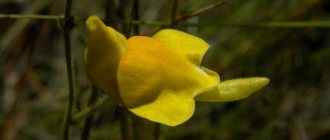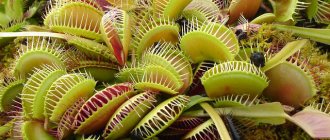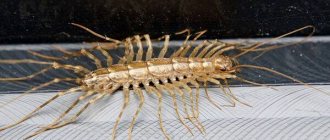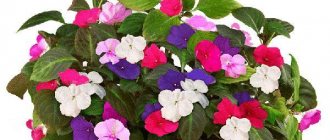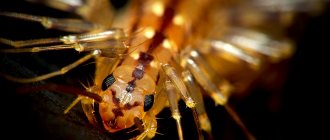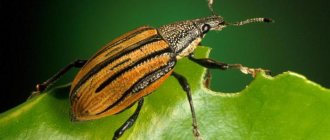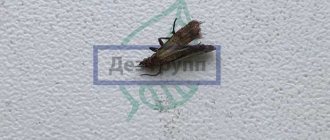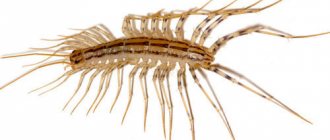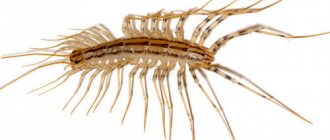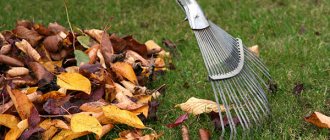Until recently, the flower that eats flies was considered a figment of fantasy, manipulation of facts and scientific errors. Charles Darwin, already famous for his theory of evolution, was heavily criticized for describing a plant that eats flies.
Moreover, for some reason, Darwin’s opponents believed that insectivorous plants refuted his theory of the origin of species. However, time put everything in its place, and the theory turned out to be correct, and the existence of predator plants was not only confirmed, but fit well into the theory of the origin of species.
Description of the plant
The Venus flytrap or Dionea is a herbaceous plant from the Sundew genus. The Latin name Dionaea muscipula translates as “mousetrap”. The meaning is used only figuratively: the plant cannot catch and “eat” a mouse.
Some believe that the plant only eats flies because that is what it is called. However, her diet may include:
- crickets;
- slugs;
- mosquitoes;
- cockroaches;
- caterpillars;
- bedbugs;
- midges and other small insects.
In their natural environment, carnivorous plants live in the wet peat bogs of the eastern American states (North and South Carolina). The first description of the Venus flytrap was made during the discovery of America; the colonialists dug up an amazing, unlike anything else plant, and took it with them to Europe.
A feature of the flycatcher, as mentioned above, is its feeding method, and Dionaea can grow only on very poor soils. It receives the nitrogen compounds necessary for the formation of proteins (building materials) exclusively from living insects, which become its prey.
The predatory part of the plant is its leaves, collected in basal rosettes. The short underground stem is bulb-shaped. The inconspicuous white flowers are arranged on long stalks to prevent pollinating insects from accidentally becoming trapped.
carnivorous plant
Sticky fat woman
Almost a complete analogue of duct tape, which just a couple of decades ago hung from the ceiling of almost every diner in the summer. True, Pinguicula, or butterwort, is much more beautiful than those dark brown spirals of the past. The bright green or pink leaves are covered on the outside with two types of cells. The pedicel glands, located closer to the stem, produce mucus containing glue that attracts with its smell, and at the same time reliably fixes insects. This is the same Velcro. The second type of cells are the so-called sessile glands. They belong directly to the digestive system and produce protease, esterase and amylase, that is, enzymes that decompose living organisms into components useful for the plant.
Some species of butterwort hide under a dense rosette for the winter, only to bloom again in the spring and continue merciless hunting, spreading carnivorous sticky leaves.
How do you catch an insect?
In the process of evolutionary development, the Venus flytrap acquired special, specialized adaptations that allow the plant to eat flies and other insects.
Compression phase
Before hunting, the Dionaea leaf turns outward, exposing sensitive hairs. The leaf has additional mechanisms for luring prey:
- bright attractive color;
- light fluorescent glow, which is activated in cloudy weather;
- a specific odorous liquid, “dew”, droplets of which are released on the surface.
An insect, landing on a leaf, touches sensitive hairs, and the trap slams shut. To avoid wasting energy on unnecessary movements, the impulse should pass twice with a break of less than 20 seconds. This measure protects against accidental operation when hit by stationary debris or raindrops.
Sealing and opening phases
After the trap is triggered, parts of the leaf bend in the opposite direction, forming a cavity inside in which the caught insect is located. The edge spines intertwine, closing the exit. If the insect was unable to escape, the process of digesting food begins. If the prey is too large or agile, it will be able to escape through the gaps between the spines.
If the trap slams shut in vain, it can open after 2-3 days, and the hunting process will start again.
A leaf can “work” and catch an insect up to 10 times, more often this happens no more than 3 times. After this, the carnivorous trap dies off, and a new one grows in its place.
Digestive mechanism
The closed trap turns into a kind of “stomach” in which digestion occurs. The trap cells begin to secrete digestive enzymes that dissolve the soft tissues of the victim's body.
The hard shells of the insects are not digested and are thrown out of the trap when the process is complete. Organic and mineral substances are absorbed by the plant and serve as nutrition.
Interesting fact! The process of how the Venus flytrap eats flies is still not fully understood. Charles Darwin, author of the theory of the evolutionary origin of species, back in the mid-19th century. was interested in the life processes of Dionaea. Because of its “bloodthirsty” nature, he called the carnivorous plant a “creepy prison” for flies and wrote a separate book where he described in detail what the Venus flytrap feeds on and the peculiarities of its “feeding.”
Digestion
Darlingtonia californica
Darlingtonia leaves are bulbous in shape and form a cavity with an opening underneath a balloon-like structure and two sharp leaves that hang down like fangs.
Unlike many carnivorous plants, it does not use trapping leaves to trap, but instead uses a crab claw type trap. Once the insect is inside, they are confused by the specks of light that pass through the plant. They land in thousands of dense, fine hairs that grow inward. Insects can follow the hairs deep into the digestive organs, but cannot return back.
Caring for a Venus flytrap at home
This exotic plant is very demanding in terms of conditions.
Location and lighting
At home, the flytrap should be placed on sunny windowsills, preferably facing south. Lighting should be at least 5 hours a day. In spring and autumn it is necessary to artificially illuminate the plant. With a lack of light, the leaves become stretched and turn pale.
Flower content temperature
Dionea is a heat-loving plant. The temperature during the active phase should be between 22-30°C.
Watering
The soil in the pot with the flytrap should always be kept moist. Water the Dionaea through a tray. To prevent the soil from drying out, you can use mulch made from natural sphagnum moss.
Watering can only be done with clean, settled rain or distilled water.
Soil and pot
In their natural environment, flycatchers grow on very poor and acidic (3.5-4.5 pH) soils. At home, they need to be provided with approximately the same conditions, since plants simply cannot live in rich, fatty substrates.
The soil mixture is made from a mixture of high-moor peat and pure quartz sand (possibly with the addition of soaked perlite).
The optimal container for the growth and development of the flycatcher will be a transparent aquarium, which will provide sufficient lighting and protection from drafts. If the plant will grow in a pot, it should be light in color so that the root system does not overheat. A prerequisite is the presence of drainage holes and a tray.
Planting and replanting Dionaea
The flycatcher must be replanted from the transport container, then replanting is not necessary provided proper watering and care.
Dionaea must be carefully removed from the pot, the soil removed, and the root system washed with clean (boiled, distilled) water. Fill the new pot to a depth of 20 cm with fresh substrate, place the Dionaea, and sprinkle the roots with soil.
To get used to it, the new plant should be placed in partial shade for a month, maintaining constant humidity.
The flower should be placed in partial shade
Venus flytrap blooming
The Venus flytrap blooms for 1.5-2 months in late spring and early summer. If the owners do not intend to propagate the plant by seeds, it is better to cut off the flower stalks so as not to deplete the strength for the formation of traps.
Fertilizers and fertilizers
The flycatcher does not need fertilizers or fertilizing, and is even contraindicated. She obtains nutrients herself from caught insects.
Attention! Dionea requires live insects to feed on it. She is unable to digest ordinary protein foods, such as raw meat.
Winter dormancy period
At the end of September, the flycatcher gradually begins to prepare for winter “hibernation”. New traps are not formed, the rosette decreases in size. In December there begins a period of rest. For 3-4 months, the plant must be provided with a temperature of 2-7 ° C, darkening, but be sure to keep the soil moist.
In February, the flower awakens and a new development cycle begins.
Reproduction of Venus flytrap
Dionaea reproduces in several ways.
- The plant constantly produces daughter bulbs. Once every three years, you can separate the children (along with the roots) from the mother plant and replant them in a new pot. The cut areas must be sprinkled with crushed coal.
- Another way of vegetative propagation is cuttings. You should choose leaves without traps or peduncles no more than 5 cm long. The cut stalk is treated with a growth stimulator (Kornevin, for example), and placed cut down on a moist substrate. The container with the seedling is placed in the sun. Within 1.5-2 months it takes root, after another 2 months the young plant can be transplanted to a permanent place.
- The most troublesome way at home is propagation by seeds, since pollination will have to be done manually. If seeds have formed, they are collected, treated with a growth stimulant and planted in moist soil prepared from sphagnum and sand in a 2:1 ratio. It is important to provide illumination for 12-14 hours a day, a temperature of at least 25°C and constant high humidity. Within a month, the seeds hatch. When several leaves appear, the seedlings are planted in separate pots with a diameter of 8-10 cm. The plant will reach adulthood in 5 years.
Devil's fingers
This mushroom at first looks like a chicken egg with a heterogeneous lumpy surface, gray in color and brownish and pinkish spots at the base. But when its blades open, it looks like a star-shaped flower with many tentacles. Inside the plant is lumpy, spongy with dark mucus. Insects are attracted to the cadaverous smell that the plant emits. A photo of a flower that eats flies is shown below.
Plants that eat flies
Diseases
Exotic flower diseases develop as a result of improper care. You can fight them with products for “ordinary” indoor plants.
- Fungus and gray mold develop due to waterlogging of the soil combined with low temperatures. It is worth optimizing the conditions for keeping Dionaea and using fungicidal preparations (Meteor, Orvego, Turion, etc.).
- Sunburn on leaves. The plant must be shaded or moved to another location.
- When using hard water , the leaves turn yellow due to excess calcium.
- With insufficient watering, the leaves turn yellow , dry out, and fall off.
- Bacterial diseases develop when the plant is unable to digest an insect caught in a trap (for example, due to its large size). The shoot begins to turn black and rot. It must be removed and the cut treated with a fungicide.
Gray rot
Some interesting facts
Among these insects there are many species with unusual feeding preferences. Let's look at what flies eat in natural conditions:
- There is a special type, cheese flies, that can breed and feed inside the cheese wheel. They are called pyophilides.
- The striped yellow-and-black syrphid, or hoverfly, a wasp-like dipteran, eats flower nectar.
- The larvae of hover flies are distinguished by an enviable appetite: during their development to an adult, each of them eats more than 2 thousand aphids.
- The dangerous Tsetse fly prefers the blood of wild animals, cattle, and people as food. The bite of this African resident can cause incurable diseases of the nervous system and immunity.
Among the flies there are also real predators, for example, ktyri, owners of a sharp poisonous sting. Their food includes mosquitoes, midges, even bees and flies. Interestingly, some types of flies are cultivated by fishing fans. Thus, the blue spring fly is specially bred on bird droppings, pig manure, its food is rotting organic remains, and the insects are also fed with sugar and dry milk.
Other houseplants that eat flies
The Venus flytrap is not the only plant that can eat flies. At home, hobbyists grow several common types of carnivorous flowers.
Sundew rotundifolia
The sundew is a flower that feeds on flies and other flying insects. The round leaf of the plant is covered with thread-like outgrowths with droplets of bait liquid at the end. The fly lands on a leaf, it closes, pushing the victim's body towards its center, where the digestion process takes place.
English sundew
English sundew is another fly-eating plant. It differs from the type of flycatcher described above in the shape of its leaf - the English drosera has an oval leaf, and when the trap is closed, it seems to wrap around the body of the prey.
Nepenthes
Nepenthes is a typical tropical vine. The flower eats flies, luring them into jugs. By the way, the second name of the plant is pitcher plant. The insect lands on the “lid”, which covers the narrow entrance (mouth) of the trap, and falls inside. The jug is filled with digestive juice and is shaped like a bottle from which flies cannot escape.
Sarracenia
Sarracenia is a plant that has been grown in homes for over 100 years. The leaves are rolled at the end into tubes that are brightly colored and have an attractive smell to insects. The flower catches flies that have fallen into the funnel, holding them with special fibers.
Sarracenia
Stapelia
Stapelia is not actually a carnivorous plant. She uses her flowers, which smell like rotten meat, to attract flies as pollinators. The fly lands on a trap flower to lay its eggs and then carries the pollen on its legs.
Darlingtonia
The bright leaves of the insectivorous plant look like the head of a cobra. The fly flies under the “lid”, loses orientation and falls to the base, where digestive fluid collects. Darlingtonia can reach 1 m in height.
Genlisey
This name has been known to plant growers relatively recently. The exotic, whimsical flower was first described only in the 80s of the 20th century. The plant has no stem and two types of leaves. Some are ordinary, collected in small rosettes, others are located in the top layer of soil and twisted into a tube. The inside of these leaves is lined with sensitive hairs to respond to prey. The tubes are filled with digestive enzymes.
Who are they, green predators
Any carnivorous plant is called insectivorous. The reason for this name is not gastronomic preferences, but the size of the organisms.
Perhaps green predators would feed on larger game, but their small size does not allow them to do so.
Predatory or carnivorous plants are a collective name rather than a taxonomic one. There are about 630 species with this specificity. They are representatives of nineteen families, which include not only predators, but also completely normal plants.
The amazing thing is that carnivorous plants are found all over the world and in different environmental conditions. They are united by only one thing - a deficiency of nitrogen in the soil or the inability to take it due to great competition.
Typically, any fly-beetle plant is a herbaceous perennial. On the territory of Russia and the CIS, 18 species, included in 4 genera and 2 families, feed on animals. These are the families of sundews and bladderworts.
The sundew family unites a small number of species that have characteristics of dicotyledonous and clove plants. This family includes three genera, all representatives of which are carnivorous plants.
These are perennial rhizomatous plants that grow in swamps. Oddly enough, in the swamps of the temperate zone, where so much dead organic matter has accumulated, there is a nitrogen deficiency, because in cold water the decomposition of organic matter to nitrates occurs extremely slowly. Additionally, plants submerged in swamp water do not grow well because the cold water cannot be absorbed properly. Accordingly, without water there is no influx of minerals. For more information about pemphigus, watch this video:
Pemphigus, which gives the family its name, has a wide range. It is not found only in Antarctica. These are aquatic carnivorous plants without roots, but with a large number of trapping bubbles. Each of them has holes with a valve. This is a typical trap into which small animals can enter, but they cannot leave. They have only one thing left to do - to become food for the plant.
Typically, such hunters have poorly developed roots, and in aquatic predators they are completely reduced. However, they do not lose their connection to the earth and the ability to photosynthesize. Only parasitic and detritivorous plants are capable of this.
